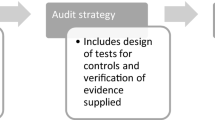Abstract
In the latest revision of the ISO/IEC 17025 standard, General requirements for the competence of testing and calibration laboratories, published in 2017, the concept of risk-based thinking was introduced in its requirements. Although the new version introduces the concept, procedures to be adopted for the implementation of risk management in testing and calibration laboratories are not addressed. The article is conceptual in nature and summarizes information from the literature to assess the application of reputable risk management models and implement them in laboratories. Furthermore, it includes discussions on the implementation of risk management in the daily laboratory operations in a practical and effective way as per the requirements of ISO/IEC 17025.
Similar content being viewed by others
References
Tranchard S (2017) ISO/IEC 17025—moves to final stage of revision. https://www.iso.org/news/ref2212.html. Accessed 30 Sept 2021
International Organization for Standardization (2017) ISO/IEC 17025—general requirements for the competence of testing and calibration laboratories. Geneva
Wong SK (2017) Risk-based thinking for chemical testing. Accred Qual Assur 22:103–108. https://doi.org/10.1007/s00769-017-1256-x
Vasilňáková A (2018) Risk management in accredited testing laboratories. https://doi.org/10.2507/29th.daaam.proceedings.153
Grochau IH, ten Caten CST (2012) A process approach to ISO/IEC 17025 in the implementation of a quality management system in testing laboratories. Accred Qual Assur 17:519–527. https://doi.org/10.1007/s00769-012-0905-3
da Silva FR, Grochau IH, Veit HM (2021) System proposal for implementation of risk management in the context of ISO/IEC 17025. Accred Qual Assur 26:271–278. https://doi.org/10.1007/s00769-021-01484-6
International Organization for Standardization (ISO) (2018) ISO 31000—risk management—guidelines. Geneva.
Project Management Institute (PMI) (2017) A guide to the project management body of knowledge (PMBOK Guide), 6th edn. Newton Square, PA
Ahmed A, Kayis B, Amornsawadwatana S (2007) A review of techniques for risk management in projects. Benchmarking Int J. 14:22–36. https://doi.org/10.1108/14635770710730919
Raz T, Hillson D (2005) A comparative review of risk management standards. Risk Manag 7:53–66. https://doi.org/10.1057/palgrave.rm.8240227
Fukayama H, Fernandes E, Ebecken NFF (2008) Risk management in the aeronautical industry: results of an application of two methods. WIT Trans Inf Commun 39, ISSN 1743-3517 (on-line), Risk Analysis VI 195. https://doi.org/10.2495/RISK080211
Haddad H, Laghzaoui F (2020) Review of risk management standards: convergences and divergences. MJQQR 2(1). ISSN: 2665-8623
Institute of Risk Management, IRM. https://www.theirm.org/what-we-do/what-is-enterprise-risk-management/irms-risk-management-standard/. Accessed 2021-03-02
Institute of Risk Management (IRM), National Forum for Risk Management in the Public Sector, Association of Insurance and Risk Managers (2002) A risk management standard. London
HM Government (2020) The orange book management of risk—principles and concepts. London
HM Treasury (2004) The orange book management of risk—principles and concepts. 1 London.
Fidélis GC (2019) The management of risks and opportunities in laboratories. http://www.cect.com.br/cadastrar_cmq44.html. Accessed 6 Aug 2020
International Electrotechnical Commission(IEC) (2019) IEC 31010:2019—risk management—risk assessment techniques. Geneva
Setton (2017) Risk management in laboratories according to ABNT NBR ISO/IEC 17025:2017. https://setton.com.br/gestao-de-riscos-em-laboratorios-de-acordo-com-abnt-nbr-iso-iec-170252017/. Accessed 15 Sept 2021
Funding
The authors did not receive financial support from any organization for the submitted work.
Author information
Authors and Affiliations
Corresponding author
Ethics declarations
Conflict of interest
The authors have no competing interests to declare that are relevant to the content of this article.
Additional information
Publisher's Note
Springer Nature remains neutral with regard to jurisdictional claims in published maps and institutional affiliations.
Rights and permissions
Springer Nature or its licensor holds exclusive rights to this article under a publishing agreement with the author(s) or other rightsholder(s); author self-archiving of the accepted manuscript version of this article is solely governed by the terms of such publishing agreement and applicable law.
About this article
Cite this article
Santana, M.K.A., Loureiro, G. Risk management approach for testing and calibration laboratories. Accred Qual Assur 27, 313–318 (2022). https://doi.org/10.1007/s00769-022-01521-y
Received:
Accepted:
Published:
Issue Date:
DOI: https://doi.org/10.1007/s00769-022-01521-y




